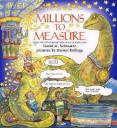Have you ever wondered how many human feet it takes to measure one foot? Or even pondered how many stones it would take to weigh a hog? From the literal sense of measuring one object one foot at a time to the meaning of the metric system today, Millions to Measure explains the history of the metric and system and how it works. Written by David M. Schwartz and illustrated by Steven Kellogg, Millions to Measure brings the world of measurement to life with full color, mystery, and wonder. The illustrations help introduce and capture an excellent representation of distance/length, mass/weight, and volume.
In the book, Marvelosissimo the Mathematical Magician takes children on a magical quest through time to discover the fantastic world of measurement. Children learn that the metric system is based on “tens, hundreds, and thousands.” Children are also shown that even a creature as small as an ant or a flea can be measured in millimeters. Millions to Measure proves to be a wonderful way to incorporate the metric system into a hidden world of magic.
Curriculum Connections
Millions to Measure includes a cleaver explanation of the metric system in a way that children can relate to and understand. The book covers volume, distance, and weight. Throughout the book, children are drawn in by the comic strips, vibrant colors, and action filled pages. Millions to Measure may be used in a classroom setting to to incorporate the basic measurement system into a lesson. For example, children would be able to have a literal sense of terms such as feet and inches. The book also includes a detailed history behind the meaning of measurement. Millions to Measure is perfect for a classroom setting because it incorporates more than the average children’s readings.
The SOL’s that most closely connect to Millions to Measure are:1.1-Length, mass, and volume are measured using standard and nonstandard units 2.1-Length, volume, mass and temperature measurements are made in metric units and standard English units 3.1 -Volume is measured to the milliliter and liter; length is measured to the nearest centimeter; mass is measured to the nearest gramThe reading covers a general basis for a traditional process skills lesson. It averages in the range of grades by allowing the teacher to either focus on the metric system in terms of simple measurement, for example with stones, to an actual scale of measurement, for example a ruler.
Additional Resources
- Measuring Marvels-This link includes a lesson plan based on the book Millions to Measure and also includes an activity sheet for students to complete (Student Activity Sheet).
- Creating One-This website contains an activity book for not only a child’s learning , but also for their enjoyment as well. It allows children to learn about the metric system in an enjoyable fashion.
- Million metric system-This provides information for other materials relating to measurement that may be used in a classroom setting. The information is updated weekly and provides an excellent outreach for similar activity books and materials.
Book: Millions to Measure
Author: David M. Schwartz
Illustrator: Steven Kellogg
Publisher: Harper Collins Publisher
Publication Date: March 2003
Pages: 40 pages
Grade Range: 1-5
ISBN: 978-0688129163

